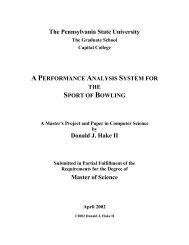k-Nearest Neighbor Classification on Spatial Data Streams Using P ...
k-Nearest Neighbor Classification on Spatial Data Streams Using P ...
k-Nearest Neighbor Classification on Spatial Data Streams Using P ...
You also want an ePaper? Increase the reach of your titles
YUMPU automatically turns print PDFs into web optimized ePapers that Google loves.
5. C<strong>on</strong>clusi<strong>on</strong><br />
In this paper we proposed a new approach to k-nearest neighbor classificati<strong>on</strong> for<br />
spatial data streams by using a new data structure called the P-tree, which is a lossless<br />
compressed and data-mining-ready representati<strong>on</strong> of the original spatial data. Our new<br />
approach, called closed-KNN, finds the closure of the KNN set, we call the closed-<br />
KNN, instead of c<strong>on</strong>sidering exactly k nearest neighbors. Closed-KNN includes all of<br />
the points <strong>on</strong> the boundary even if the size of the nearest neighbor set becomes larger<br />
than k. Instead of examining individual data points to find nearest neighbors, we rely<br />
<strong>on</strong> the expansi<strong>on</strong> of the neighborhood. The P-tree structure facilitates efficient<br />
computati<strong>on</strong> of the nearest neighbors. Our methods outperform the traditi<strong>on</strong>al<br />
implementati<strong>on</strong>s of KNN both in terms of accuracy and speed.<br />
We proposed a new distance metric called Higher Order Bit (HOB) distance that<br />
provides an easy and efficient way of computing closed-KNN using P-trees while<br />
preserving the classificati<strong>on</strong> accuracy at a high level.<br />
References<br />
1. Domingos, P. and Hulten, G., “Mining high-speed data streams”, Proceedings of ACM<br />
SIGKDD 2000.<br />
2. Domingos, P., & Hulten, G., “Catching Up with the <strong>Data</strong>: Research Issues in Mining <strong>Data</strong><br />
<strong>Streams</strong>”, DMKD 2001.<br />
3. T. Cover and P. Hart, “<str<strong>on</strong>g>Nearest</str<strong>on</strong>g> <str<strong>on</strong>g>Neighbor</str<strong>on</strong>g> pattern classificati<strong>on</strong>”, IEEE Trans. Informati<strong>on</strong><br />
Theory, 13:21-27, 1967.<br />
4. Dasarathy, B.V., “<str<strong>on</strong>g>Nearest</str<strong>on</strong>g>-<str<strong>on</strong>g>Neighbor</str<strong>on</strong>g> <str<strong>on</strong>g>Classificati<strong>on</strong></str<strong>on</strong>g> Techniques”. IEEE Computer Society<br />
Press, Los Alomitos, CA, 1991.<br />
5. Morin, R.L. and D.E.Raeside, “A Reappraisal of Distance-Weighted k-<str<strong>on</strong>g>Nearest</str<strong>on</strong>g> <str<strong>on</strong>g>Neighbor</str<strong>on</strong>g><br />
<str<strong>on</strong>g>Classificati<strong>on</strong></str<strong>on</strong>g> for Pattern Recogniti<strong>on</strong> with Missing <strong>Data</strong>”, IEEE Transacti<strong>on</strong>s <strong>on</strong> Systems,<br />
Man, and Cybernetics, Vol. SMC-11 (3), pp. 241-243, 1981.<br />
6. William Perrizo, "Peano Count Tree Technology", Technical Report NDSU-CSOR-TR-<br />
01-1, 2001.<br />
7. Jiawei Han, Micheline Kamber, “<strong>Data</strong> Mining: C<strong>on</strong>cepts and Techniques”, Morgan<br />
Kaufmann, 2001.<br />
8. M. James, “<str<strong>on</strong>g>Classificati<strong>on</strong></str<strong>on</strong>g> Algorithms”, New York: John Wiley & S<strong>on</strong>s, 1985.<br />
9. William Perrizo, Qin Ding, Qiang Ding and Amalendu Roy, “On Mining Satellite and<br />
Other Remotely Sensed Images”, DMKD 2001, pp. 33-40.<br />
10. William Perrizo, Qin Ding, Qiang Ding and Amalendu Roy, “Deriving High C<strong>on</strong>fidence<br />
Rules from <strong>Spatial</strong> <strong>Data</strong> using Peano Count Trees", Springer-Verlag, Lecturer Notes in<br />
Computer Science 2118, July 2001.<br />
11. Qin Ding, Maleq Khan, Amalendu Roy and William Perrizo, “The P-tree Algebra”,<br />
proceedings of the ACM Symposium <strong>on</strong> Applied Computing (SAC'02), 2002.
















